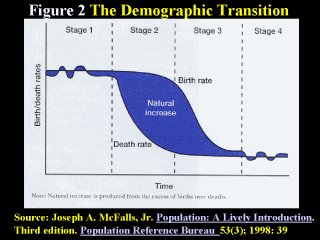| front |1 |2 |3 |4 |5 |6 |7 |8 |9 |10 |11 |12 |13 |14 |15 |16 |17 |18 |19 |20 |21 |22 |23 |24 |25 |26 |review |
 |
The demographic
transition is presented as a function of time and socioeconomic development. It traces a
change from a state where a population experiences high rates of mortality and fertility,
and hence a low rate of natural increase (Stage I), to one where the mortality and
fertility rates are low - as is the rate of natural increase (Stage IV). Stages II and III
are characterized by high population growth rates due to large discrepancies between
respective birth and death rates. A fluctuating mortality rate in Stage I reflects human helplessness in the face of epidemics, wars and other natural and manmade calamities. The fluctuating fertility rate in Stage IV suggests human decision-making that is sensitive to economic change, and facilitated by modern methods of contraception. Noteworthy, the post-World War 11 baby boom in the United States and other industrialized countries was a mere “boomlet” compared to the population explosion of the demographic transition. The demographic transition, as theory or concept, cannot be attributable to one person. Rather it reflects the work of a number of scholars including Carlos P. Blacker, Kingsley Davis, Adolphe Landry, Frank Notestein, and Warren Thompson. Reference: Dudley Kirk. Demographic Transition Theory. Population Studies 50; 1996: 361-387. |